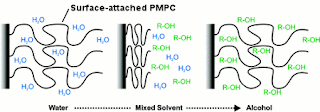 Here’s a fun experiment for your kitchen, with safe ingredients from the supermarket and a surprising result. You will need:
Here’s a fun experiment for your kitchen, with safe ingredients from the supermarket and a surprising result. You will need: - Gaviscon liquid, a common treatment for heartburn
- Vinegar (I’ve used 5% acidity distilled vinegar, but anything should work)
All you have to do is mix 1 teaspoon (5ml) of Gaviscon liquid with 3 tablespoons (45 ml) of water and stir to disperse the Gaviscon into the water. Then, add 1 teaspoon (5ml) of the vinegar and immediately stir the mixture for a few seconds.
You get an incredible change – within a few seconds, the watery liquid turns into a squishy lump of gel! Over the next minute or so, bubbles form and the gel expands slightly. The gel is quite stiff, but quite easy to break apart with your fingers. It was quite difficult to get out of the cup, since the gel is slowly expanding and gripping the sides. It also tastes quite good, but I should probably recommend that you don’t try that…
What’s going on? I’m not going to let you get away with having fun without learning something, so let’s delve in.
Gaviscon is a treatment for heartburn, which is often caused by stomach acid getting into the wrong place. The main ingredients in Gaviscon are sodium bicarbonate and calcium carbonate, which are both bases. They react with the excess stomach acid to neutralise it (which is why it relieves the heartburn), producing salts, water and CO2 gas. Our vinegar is acting in the same way as the stomach acid, which explains where the little bubbles in the gel come from – they are CO2 generated from the acid+base reaction.
But what about the gel? The other main ingredient apart from water in Gaviscon is sodium alginate, a water soluble polymer extracted from seaweed. Gaviscon is a rather thick liquid, and this is because the sodium alginate polymer chains get tangled up with each other in the liquid, making it harder for the whole thing to flow.
The “-ate” ending in name of sodium alginate tells us this is a salt. That is, the product of an acid+base reaction itself. In this case the parent acid is alginic acid, which has lots of acid groups all along the length of the polymer chains. In the alginate form, these acid groups have a negative charge (as COO-) which helps keep them apart since like charges repel, and stops them getting too tangled. When we add the vinegar, which contains acetic acid, we get another acid+base reaction: sodium alginate + acetic acid --> alginic acid + sodium acetate. Alginic acid no longer has these negative charges (the COO- groups get converted to COOH) and the polymer is no longer very soluble. The polymer chains get strongly bonded together, forming a network throughout the liquid with the water trapped in between the chains. This is why we get a gel! This is probably what also happens in your stomach when you swallow the liquid, helping the Gaviscon to coat and stick to your insides.
You can also do a fun (and messy!) experiment to optimise the amount of Gaviscon and vinegar in the gel, but I’ll report on that in a separate post.
In my real job, I also play with polymers with solubility that depends on pH in the same way as sodium alginate. We've used these polymers to coat particles to produce pH-responsive suspensions, conduct fundamental studies into the swelling of thin films using several different analytical techniques, create sensors and study surfactant assembly.
Enjoy!
Footnote to fellow chemists; I think I’m right about the mechanism here. The pKa of the alginate acid groups is 3.4 and 3.7, as reportedby FMC BioPolymer. The pH of vinegar is apparently about 2.4, and I’m diluting by about 10x, which should give a pH of 2.9, enough to deprotonate the alginate. There could easily be something else going on here though – alginate also gels in the presence of calcium, which is definitely present in the calcium carbonate. Acetic acid + calcium carbonate gives calcium acetate, which would presumably dissolve and also gel the alginate?


























